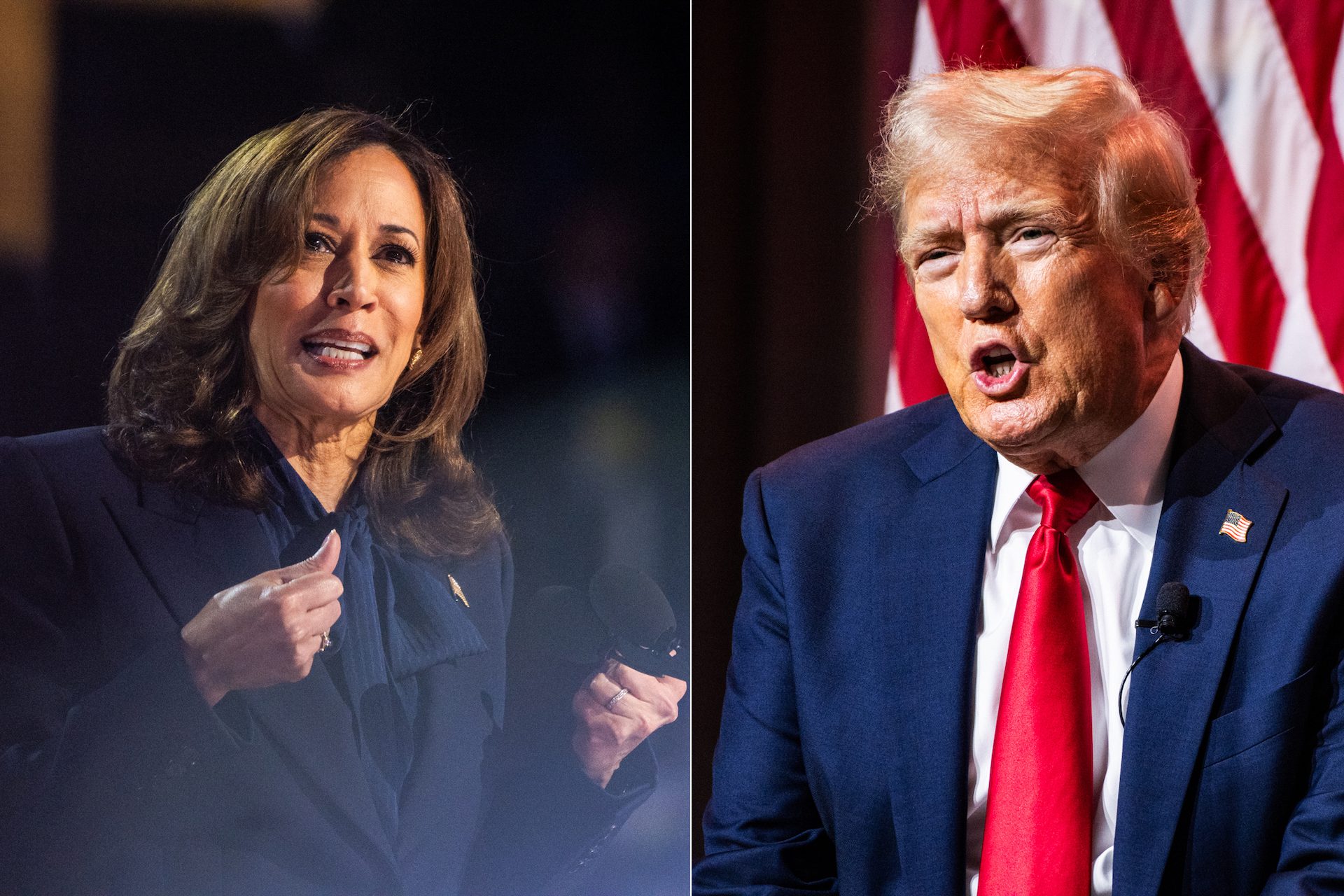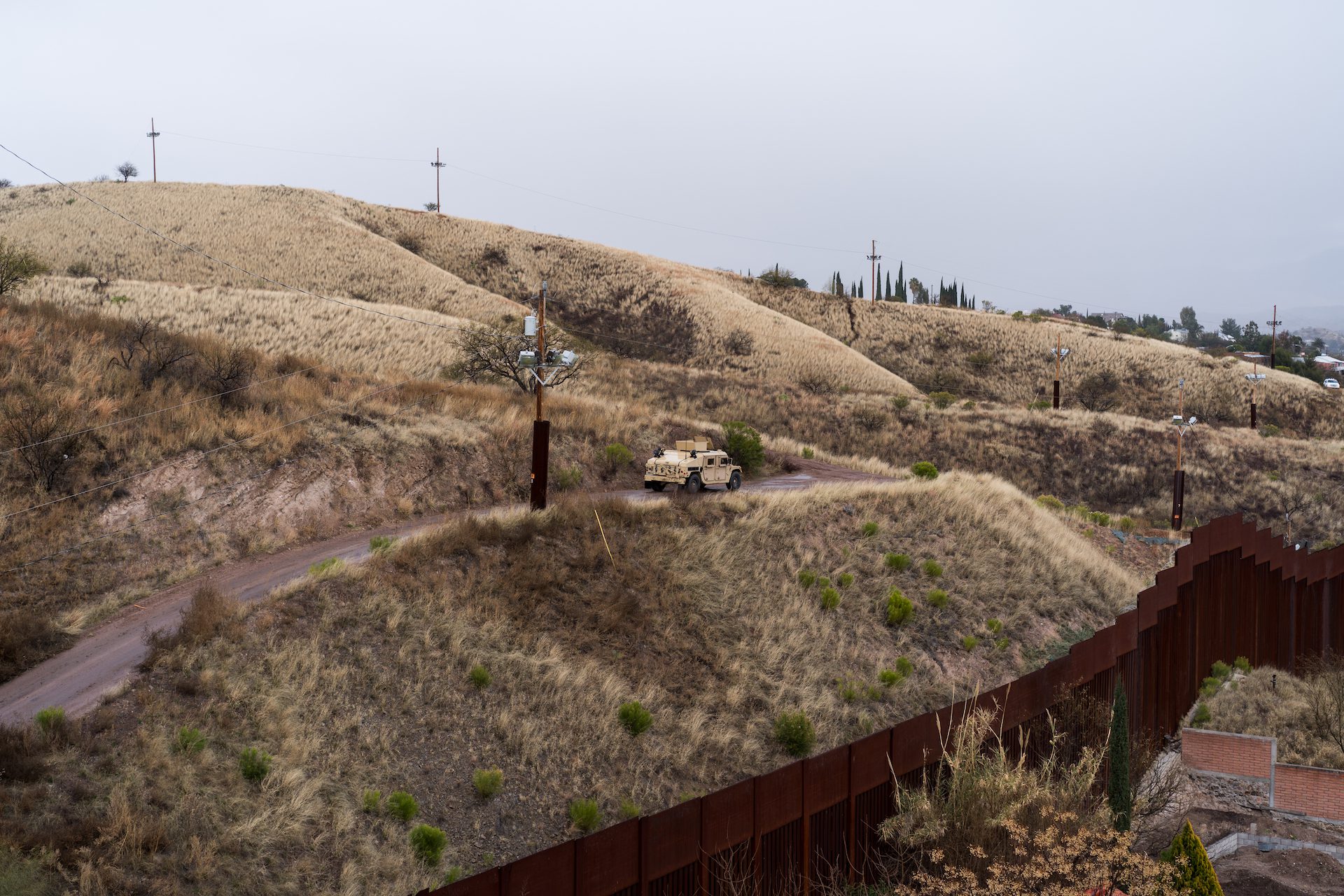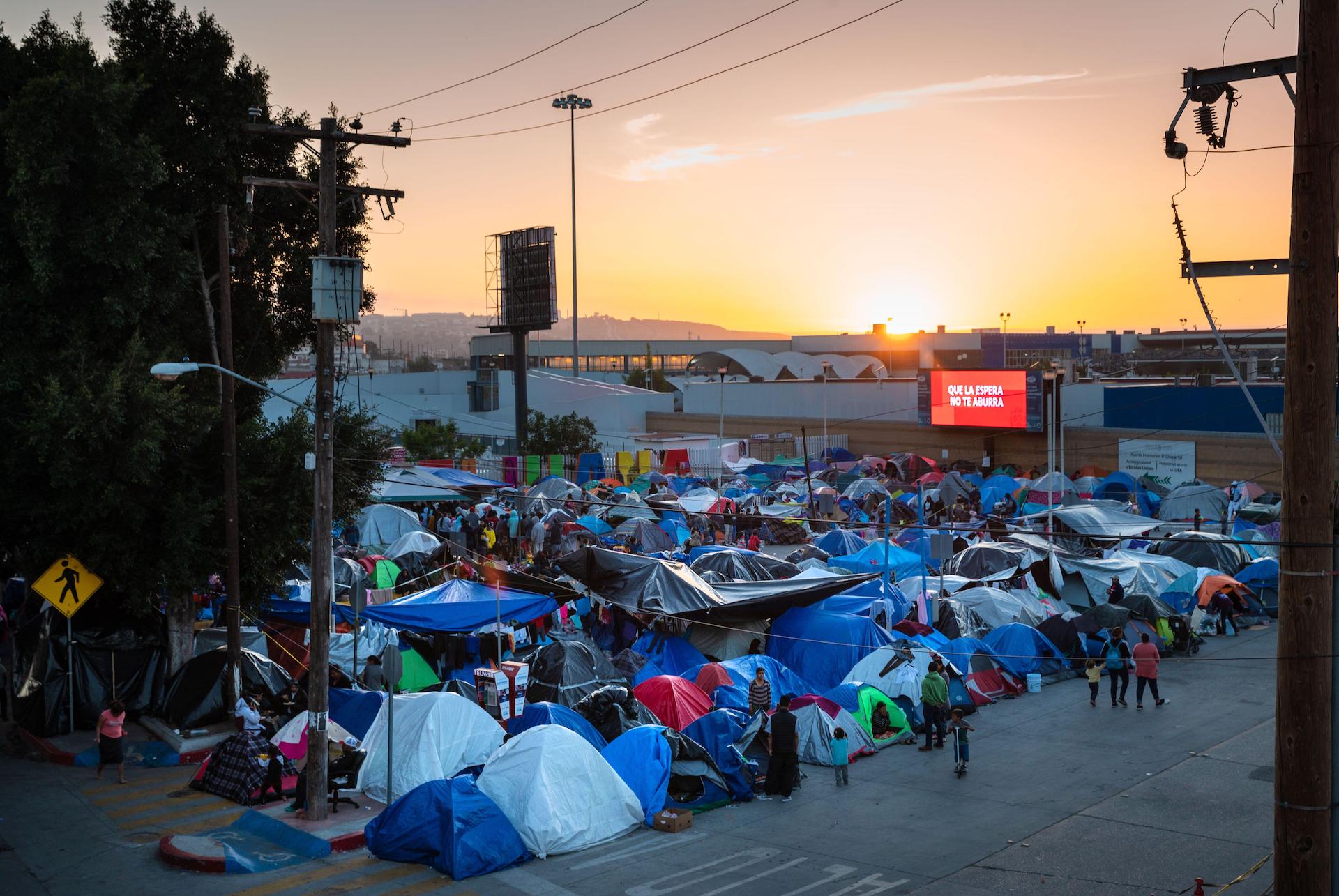 Source photos: Colin Boyle/Block Club Chicago
Source photos: Colin Boyle/Block Club ChicagoWhile Vice President Kamala Harris has shifted her stance on the border to align more closely with Donald Trump, the candidates diverge on DACA, temporary protected status, and deportation.
Immigration has been a focal point throughout the 2024 presidential election, especially amid the recent increase in migration to the United States.
Former President Donald Trump and Vice President Kamala Harris have taken a hardline stance on the issue, promising some of the most restrictive immigration policies in decades.
Trump has pledged mass deportations, greater restrictions for asylum seekers, and limitations on access to citizenship and visas. Meanwhile, Harris has leaned on her career as a prosecutor and attorney general as she’s toughened her stance on initiatives to fortify the southern border.
News that puts power under the spotlight and communities at the center.
Sign up for our free newsletter and get updates twice a week.
Across party lines, registered voters are looking at how Trump and Harris will respond to immigration — although a larger share of registered Republicans say immigration is very important to them when casting their vote, according to Pew Research Center.
This comes after a steep increase in migration to the U.S. following the COVID-19 pandemic. According to data from the U.S. Customs and Border Patrol and Pew Research Center, border encounters hit a seven-year peak in 2023 before falling sharply in 2024.
“Democrats and Republicans are — not quite agree[ing] on — but are converging around the fact that the U.S.-Mexico border is not manageable with the tools that we currently have,” said Colleen Putzel-Kavanaugh, an associate policy analyst with the Migration Policy Institute. “Though the solutions remain quite different.”
While Harris has shifted her stance on the border to align more closely with Trump, the candidates diverge on pledges around asylum, temporary protected status and deportation. Here’s a breakdown of where Harris and Trump stand on different immigration issues.
The Border
Some Democratic and Republican voters have opposed President Joe Biden’s handling of the border, and some polling shows increased interest in slowing migration to the U.S. Both candidates have aligned on rhetoric to “secure the border,” pledging increased border patrol and expansions on asylum restrictions to try to curb border migration.

TRUMP: The former president has doubled down on anti-immigrant rhetoric that was a centerpiece of his first term. If re-elected, one of his top policy priorities is to “seal the border.”
Trump has promised to reinstate Title 42, a policy that he previously utilized during the COVID-19 pandemic to turn away and deny asylum seekers from entering through the U.S.-Mexico border. He also plans to reinstitute the Migrant Protection Protocols (MPP), also known as his ‘Remain in Mexico’ policy, which required asylum seekers to wait in Mexico — oftentimes in dangerous conditions — during their immigration court proceedings.
For his second term, Trump vows to reinstate his Muslim travel ban, which barred immigrants from six Muslim-majority countries from entering the United States in 2017. President Biden later reversed the ban.
“Day one, I will seal the border,” the former president said at a Pennsylvania rally in October. “…and we will begin the largest deportation operation in the history of our country.”
After years of building up foreign countries, we are finally going to build up our Country, defend our borders, and protect our cities. We will not be invaded. We will not be occupied. We will not be conquered. We will be a free and proud nation once again! pic.twitter.com/LqWWxBdhET
— Donald J. Trump (@realDonaldTrump) October 20, 2024
Read More of Our Coverage
HARRIS: The Vice President promises to take a similarly strict approach to the border. However, she hasn’t promoted policies barring specific immigrant groups from entering the U.S. based on their country of origin. Instead, she has advocated for greater investments in border security, including increasing the number of Border Patrol agents at the southern border.
Harris has criticized Trump and accused him of not being interested in fixing the immigration system. Harris has repeatedly emphasized her desire to pass the Border Act of 2024. The bipartisan Senate immigration bill introduced earlier this year that would have increased financial investments in CBP and ICE by billions of dollars while expanding accessibility for Green Cards and family-based visas.
“Earlier this year, we had a chance to pass the toughest bipartisan border security bill in decades, but Donald Trump tanked the deal because he thought by doing that it would help him win an election,” she said during an Arizona rally. “But when I am president, I will sign the bill.”
Donald Trump tanked the toughest bipartisan border security bill in decades because he thought it would help him win an election.
When I am President, I will sign the bill. pic.twitter.com/Vlu4KdUdiI
— Kamala Harris (@KamalaHarris) August 10, 2024
Asylum
Harris’ support for Biden’s recent asylum restrictions and the failed bipartisan Senate immigration bill and Trump’s historic approach to asylum may provide some clues about how each might approach asylum in the upcoming election.
Asylum is a protection offered through U.S. immigration law for those who can prove they were persecuted or face a fear of persecution in their home countries because of their race, religion, political opinion and nationality.
Under federal law, immigrants claiming asylum are allowed to enter the U.S. and make their case domestically in immigration court before receiving an order of removal. However, immigration courts across the country face a large backlog of ongoing cases that make the asylum process long, and many asylum cases take years to complete. The average wait time for an asylum application in immigration court is roughly four years, according to an analysis from the National Immigration Forum.

HARRIS: Alongside her promise to secure the border, Harris’ immigration platform includes plans to further limit access to asylum for migrants.
She appears poised to expand and maintain the Biden administration’s recent decision to limit asylum screenings at the border. The executive order capped asylum access when border crossings hit 2,500 per day. The border crossings must be below 1,500 for almost a month before asylum restrictions are lifted, according to the executive order.
The failed bipartisan border bill, also supported by Harris, would have increased funding for asylum officers, raised the bar for asylum applications and turn away those who don’t qualify.
The bill, which would also require asylum cases to be processed within 90 days, has been met with criticism from immigrant rights advocacy organizations that say the expedited timeline would result in cases being rushed as asylum officers try to meet “an impossible task.”
“This bill limits access to asylum by creating a heightened standard and setting up rapid processing at the cost of due process,” the organizations stated in the letter this fall.
According to the Migration Policy Institute, Harris’ focus on border security is a stark departure from President Joe Biden’s 2020 campaign pledge to halt border wall construction and reverse former President Donald Trump’s border policies.
“While policies narrowing access to asylum and expanding the border wall were once demonized by Democratic Party leaders, they are now a core element of party orthodoxy, though Democrats also extol the benefits of legal immigration and continue to press for legalization for Dreamers and other long-resident unauthorized immigrants,” according to the report.
TRUMP: The former president has historically tried to dismantle the asylum system, and, if re-elected, would likely enact further limitations on the process.
During his first term, Trump attacked asylum’s legality, expelled asylum seekers at the border, and made it more difficult for asylum seekers to apply for and attain asylum status. For example, his Remain in Mexico (MPP) policy required asylum seekers to wait in Mexico during their immigration proceedings.
“BIG United States Supreme Court WIN for the Border on Asylum!” Trump tweeted in 2019, following a Supreme Court decision allowing enforcement of his administration’s rule that prevented most Central American migrants from seeking asylum in the U.S.
Read More of Our Coverage
Deportation and Pathways to Citizenship
TRUMP: The Republican candidate has repeatedly promised to enact mass deportations of people who have entered the country without authorization.
During a rally in Aurora, Colorado, Trump pledged to invoke the Alien Enemies Act of 1798 to pursue ‘Operation Aurora,’ an effort that would deport immigrants in the state whom Trump has blamed for crime and violence.
The Alien Enemies Act has only been used three other times in U.S. history — during the War of 1812, World War I, and World War II. The centuries-old law allows a president to detain, relocate or deport noncitizens from a country considered an ‘enemy’ of the U.S. during wartime.
A variety of sources have debunked the disinformation that migrants increase crime in cities and states.
Trump has also expressed a desire to support ‘merit-based’ immigration, increase the barriers to obtaining U and T visas for victims of crimes and human trafficking, end birthright citizenship, and limit protections for Afghans and Ukrainians with humanitarian parole.
The former president has been outspoken about programs like Deferred Action for Childhood Arrivals (DACA) and Temporary Protected Status (TPS). DACA protects people who were brought to the country without documentation as children, while TPS protects those who cannot return to their home countries because of unsafe conditions. He previously ordered the end of the TPS program for Haitians in 2017, resulting in the displacement of more than 300,000 Haitian immigrants who faced deportation due to the sudden end of their protected status.
During his term, Trump attempted to end DACA by barring new applications from being accepted. After the Supreme Court sided with DACA recipients, also known as “Dreamers,” Trump vowed again to end DACA in 2020. The program continues to face legal challenges in federal court, and the battles over its legality have left thousands in limbo as they await a final decision on their status as DACA recipients.
Read More of Our Coverage
HARRIS: Alongside her strict border measures, the Democratic nominee has offered support for ‘earned pathways to citizenship.’ However, Harris has provided few details on how she aims to ensure those pathways to citizenship.
“I have met with so many of our Dreamers throughout my career,” Harris said during her visit to the southern border in Arizona in September. “They are American in every way. But still, they do not have an earned pathway to citizenship. And this problem has gone unsolved at this point now for decades.”
The Harris-supported Border Act of 2024 includes an expansion of the Green Card program through family and employment-based visas and a pathway to citizenship for Afghans paroled into the country after helping the U.S. government during the war. However, the bill did not include updates for Dreamers on the state of DACA.
Katrina Pham is Borderless Magazine’s audience engagement reporter. Email Katrina at [email protected].



